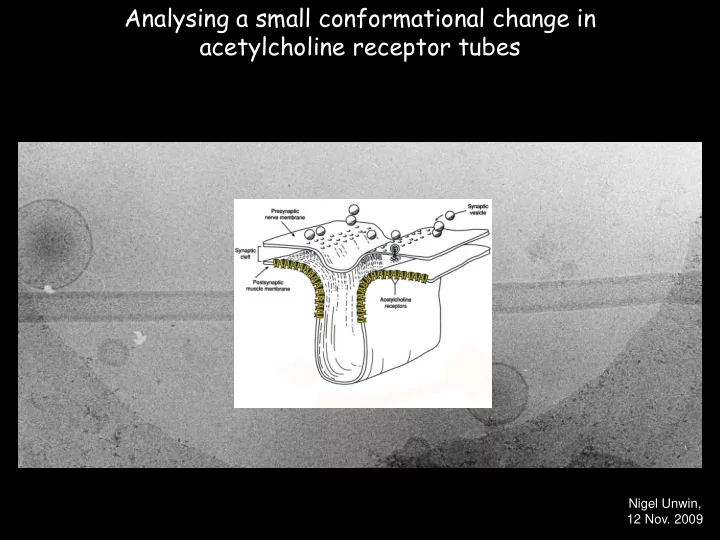

Analysing a small conformational change in acetylcholine receptor tubes Nigel Unwin, 12 Nov. 2009
Postsynaptic membranes from the Torpedo ray
What is the single most important step in getting high quality structures? Specimen preparation Pre-irradiation of carbon film helps in 3 ways: 1. creates reproducible surface properties, following carbon evaporation, removal of plastic etc. 2. strengthens the film, reducing breakage and minimising specimen drift 3. increases electrical conductivity of the carbon film (>2x) and so reduces the effects of charging
Images of ACh receptor tubes only diffract to about 1/30Å, but can be improved by distortion corrections Beroukhim & Unwin, Ultramicroscopy 70:57 (1997 )
Architecture of ACh receptor δ 6 β α α γ Miyazawa et al., Nature 423:949 (2003) Unwin, J Mol Biol. 346:967 (2005)
Torpedo ACh receptor and related proteins AChBP (2.7 Å) Brejc, Sixma et al. Nature 411;269-276 (2001) Mouse α 1(1.94Å) Dellisanti, Chen et al. Nature Neurosc. 10:953-962 (2007) native membrane E L I C (3.3Å) Hilf and Dutzler, Nature 452:375-379 (2008)
Fit of mouse α subunit ligand-binding domain to Torpedo ACh receptor β -sheet core r.m.s deviations (Å): α m / α γ = 2.16 α m / α δ = 2.10 C-loop α m / β = 2.17 α m / γ = 1.81 α m / δ = 1.86 ( α γ / AChBP = 2.43) Cys-loop Dellisanti, Chen et al., Nat. Neurosci. 10: 953-962 (2007)
Comparison of ACh receptor with x-ray structures of pentameric prokaryotic channels ELIC 3.3Å UDM, pH 6.5 Nature 452: 375 (2008) GLIC 2.9Å, DDM, pH 4.0 Nature 457:111 (2008) GLIC 3.1Å, TDM, pH 4.6 Nature 457: 115 (2008)
Comparison of pore dimensions of ACh receptor with prokaryotic pentameric ion channels ACh receptor ELIC ‘closed’ GLIC GLIC ‘apparently ‘potentially open’ open’
The open-channel form of the receptor
Suggested conformational change γ β 8 M3 10 ° M4 α β 1- β 2 Cys loop α M2 M1 M4 M3 M1 M2 δ β α subunit
Freeze-trapping experiments Que uesti tions ons: What are the actual ACh-induced movements in the ligand-binding domain? How do they bring about the change in configuration of helices in the membrane (coupling across interface)? What is the change in helix configuration which opens the pore and lets ions through? Str trate tegy gy: Mimic synaptic activation (ACh concentration, duration and membrane setting). Minimise effects of systematic errors by comparing ACh-activated and non-activated tubes from the same em grids.
Mimicking s y naptic activation by plunge-freezing ferritin I ~10ms
Manzello & Yang, Exps. in Fluids, 32: 580 (2002 )
Unfortunately 10 ms reaction time causes some short-range disorder Dilger and Brett, Biophys J. 57: 723 (1990) loss of crystal contact near appearance of desensitised ACh binding site conformation
1 µ m droplet after 10 ms Berriman & Unwin, Ultramicroscopy 56:241 (1994)
Classification of ‘open’ vs ‘closed’ tubes First, what resolution can you expect from a single short (~5000Å long) tube? FSC 0.5 = 20Å The helical structure would be equivalent to a structure obtained from 1500 single particles, with perfect alignment and equal sampling of all views So 20Å is the highest resolution obtainable in practice from only 1500 (non-symmetric) single particles
Classification of ‘open’ vs ‘closed’ tubes The most reliable ‘simple’ method to discriminate is: 1. Use only the terms along layer-lines to eliminate all non-relevant information 2. Reconstruct structure of a single molecule to 20Å resolution 3. Select the portion of the structure where the two conformations will be most different (between binding site and gate) 4. Correlate this portion with equivalent portions from the ‘open and ‘closed’ reference maps
Differences in correlation coefficient, obtained by comparing 3-D maps calculated from each image with either reference structure ‘closed’ ‘open’ No. images -0.06 0 +0.06 cc(o) - cc(c)
Regions showing most significant structural change (pink: increase, blue: decrease in density associated with addition of ACh) difference between reference structures difference between sorted structures Contours at p=0.001
Poor images may have a disproportionately bad effect on the averaged data set: how do you identify them? ‘Ghosts’ are present in averaged 3D maps calculated from images of ACh- activated tubes because some tubes exhibit short-range disorder due to the loss of a crystal contact. (1/7 Å -1 ) To identify (and subsequently eliminate) bad images: One way is to remove the suspect image from the averaged dataset and see if measures of agreement with a known structure, and annular phase errors in the Fourier transform improve or get worse Another (less objective) way is to include the image in the data set at say 10x its correct weight and look at the effect on the 3D map.
ACh binding site at contact between α subunits closed class open class α γ AChBP C loop
Cross-section through membrane near gate α β γ δ α closed class open class
Answers to left-over question
What sorts of questions about membrane proteins are better answered by EM than by x-rays? Understanding biological mechanisms, where you need to examine transient, or unstable physiological states Analysis of large membrane complexes, which are naturally heterogeneous (e.g. synaptic vesicles), or too difficult to crystallise because of conformational variability etc. Investigation of proteins in their cellular context (e.g. architecture of ACh receptor clusters at the synapse) In principle, EM provides the best opportunity to derive a definitive picture of a working protein, because it allows you to analyse it in a physiological ionic environment and a native membrane setting. EM can tell you whether an x-ray structure is meaningful or meaningless.
Recommend
More recommend